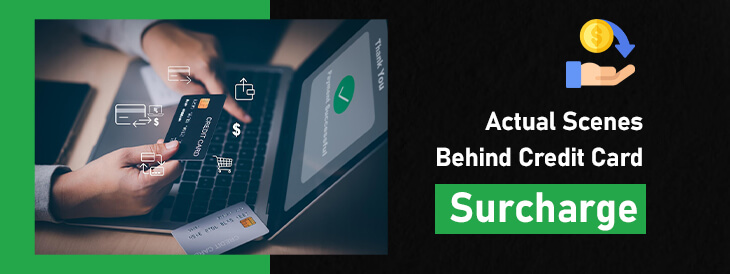Actual Scenes Behind Credit Card Surcharge
Actual Scenes Behind Credit Card Surcharge

Credit card surcharging is a common practice in the world of retail and e-commerce, yet it remains a largely misunderstood concept. Many consumers may not even be aware of its existence, while merchants struggle with the decision to implement it. In this blog post, we will dive into the world of credit card surcharging and explore it from the perspective of merchants, shedding light on the reasons behind its use and how it affects their business operations.
Introduction
Credit card surcharging is a common practice in the world of retail and e-commerce, yet it remains a largely misunderstood concept. Many consumers may not even be aware of its existence, while merchants struggle with the decision to implement it. In this blog post, we will dive into the world of credit card surcharging and explore it from the perspective of merchants, shedding light on the reasons behind its use and how it affects their business operations.
Some Related Blogs
- Streamline Payments With Payment Gateway!
- Breaking Down Business Fixed Cost: Tips For Optimizing Your Expenses
- Advantages Of Online Payment Processing For Nonprofits
- Taking Your Reward Points Program To The Next Level With A Merchant Account
What is Credit Card Surcharging?
Credit card surcharging is a fee that merchants add to a customer’s transaction when they choose to pay with a credit card. It is a way for businesses to offset the costs associated with processing credit card payments. The surcharge is typically a percentage of the total transaction amount, and it is disclosed to the customer at the time of purchase. While credit card surcharging can be beneficial for merchants, it is important for consumers to understand the implications and potential costs involved.
The Legality of Credit Card Surcharging
One important aspect to consider when it comes to credit card surcharging is its legality. The practice of surcharging credit card transactions is regulated differently in various countries and regions. While some jurisdictions allow merchants to charge customers a surcharge, others strictly prohibit it.
It is crucial for merchants to familiarize themselves with the laws and regulations in their specific location to ensure they are compliant. Failure to adhere to the legal requirements can result in fines and penalties, which can significantly impact a merchant’s business.
Why Merchants Implement Credit Card Surcharging
Merchants implement credit card surcharging for a variety of reasons. Firstly, it helps them cover the fees charged by credit card processors, which can significantly impact their profit margins. Secondly, it allows merchants to offer lower prices to customers who pay with cash or alternative payment methods.
Additionally, credit card surcharging can help deter customers from using credit cards for small purchases, which can save merchants on transaction costs. Ultimately, implementing credit card surcharging can be a strategic business decision for merchants looking to optimize their operations.
How Merchants Decide on the Surcharging Fee
Determining the surcharging fee is a critical decision for merchants. Factors such as industry standards, transaction volume, and profit margins all come into play.
Merchants need to strike a balance between covering their costs and not discouraging customers from using credit cards.
Conducting market research, analyzing competitors’ practices, and considering customer preferences can help merchants set a fair and reasonable surcharging fee.
It’s a delicate process that requires careful consideration to ensure both merchant profitability and customer satisfaction.
Communicating Credit Card Surcharging to Customers
When it comes to communicating credit card surcharging to customers, transparency is key. Merchants should clearly inform customers about the surcharge at the time of purchase, either through signage or verbal communication. It’s important to explain the reason behind the surcharge, such as covering processing fees, and highlight any alternative payment methods that don’t incur the surcharge. By being upfront and informative, merchants can help customers understand the surcharge and reduce any potential friction in the payment process.
Pros and Cons of Credit Card Surcharging
Credit card surcharging has its advantages and disadvantages. On the positive side, it allows merchants to cover the fees associated with credit card transactions and offer lower prices for cash-paying customers. It can also help deter customers from using credit cards for small purchases.
However, there are drawbacks too. Some customers may be deterred by the surcharge and choose not to make a purchase. Additionally, implementing and managing credit card surcharging can be complex and time-consuming for merchants. It’s important for merchants to weigh the pros and cons before deciding to implement credit card surcharging.
Tips for Merchants Implementing Credit Card Surcharging
If you’re considering implementing credit card surcharging for your business, here are some tips to keep in mind. First, make sure you understand the laws and regulations in your specific location to ensure compliance. Conduct market research and analyze your competitors’ practices to set a fair and reasonable surcharging fee.
Be transparent with your customers by clearly informing them about the surcharge and the reasons behind it. Lastly, continuously evaluate and adjust your surcharging strategy based on customer feedback and industry trends.

Email us anytime!
Email customer service 24/7 at info@payment-guru.com

Call us anytime!
Reach customer care 24/7 at +1 (617) 616-8547
